Publisher: Amy Marson Creative Director: Gailen Runge Editor: Karla Menaugh Technical Editors: Priscilla Read and Carolyn Aune Cover/Book Designer: Page + Pixel Production Coordinator: Freesia Pearson Blizard Production Editor: Katie Van Amburg, Alice Mace Nakanishi, and Jennifer Warren Illustrator: Kirstie Pettersen Photo Assistant: Sarah Frost Style photography by Page + Pixel and instructional photography by Diane Pedersen, unless otherwise noted DEDICATION For Tess and Eli, my favorite people to make quilts for ACKNOWLEDGMENTS Thanks to my agent, Hilary McMahon, for her enthusiasm and hard work. Thanks to Roxane Cerda, who thought this book was a good idea in the first place and helped get it started in the right direction. Thank you to Liz Aneloski and Karla Menaugh for answering many questions and applying their keen editing skills to these pages. To everyone on the C&T team, who all did what they do best, my sincerest thanks. To my quilting friends near and far, huge thanks for saving and sending selvages to me. This book would have been impossible without the help of many generous quilters.
To Timeless Treasures, Dear Stella, and Riley Blake Designs, thanks for making fabulous fabrics in general, but more specifically thanks for sending me fabrics and selvages to use for the projects in this book. Thanks to Tina Hanson for her perfect stipple and all-around quilting skills. Shes the only person besides me to ever quilt my selvage quilts, so when it came time for the ones in this book, she was of course the only choice. Thanks to the many people in the quilting and arts communities whove been encouraging and supportive of what I do. Finally, and most of all, thanks and love to my husband, Shane, and my children, Tess and Eli, for tolerating the sound of my sewing machine running in the background of their lives.  THE BEGINNINGI have no idea who started all this. I never metin fact I dont even know the name ofthe woman who first made me think I could be a quilter.
THE BEGINNINGI have no idea who started all this. I never metin fact I dont even know the name ofthe woman who first made me think I could be a quilter.
And there was another woman who helped too, but alas, I dont know anything about her either. I only remember what she once told me. Well, if you want, she said, you can fill a whole bag for $5. That is whats most important to this story. Let me set the scene. Its a sunny, clear morning in a small town in New Brunswick, Canada.
A Saturday in early May. Im standing on the dewy lawn of a strangers house. Other people are here too. Theyre circling the many tables, rows of cardboard boxes lining the driveway, and blankets spread on the grass like giant place mats. Its a yard sale. But more than that, its the estate sale of a quilter.
So now reimagine those tables. Theyre piled with fabric. In the boxes? More fabric. Those boxes over there too? Yes indeed: fabric. On the blankets? Well, pots and pans and kitchenware actually, but at the edges are bags of scraps, batting bits, and cotton strips. Im drawn to it all because its colorful.
Reds and pinks. Rich turquoise. A large orange rectangle with yellow dots. She liked brights, this unknown quilter. This is good. I browse. I browse.
I unfold pieces and try to refold them somewhat neatly. I wander around, enjoying myself, but I also wonder why anyone would ever need so much fabric. This hoard seems record setting. Really, how many quilts can a person make? (Of course, unbeknownst to me was the fact that what I was seeing was a pretty tame stash, and within two years I would accumulate almost as much.) I stir through boxes. A woman approaches. Are you a quilter? she asks.
Oh, no, I say. I just like looking at the fabric. Then the fateful line. Well if you want, she says, you can fill a whole bag for $5. She gestures widely with her arm. Theres lots to choose from.
Something clicks. Its like an imaginary presser foot snaps down on part of my brain. I interpret it as: I need some of this. Really, how can I resist? I walk back to the car, where my husband is waiting, and tell him I might be a while. Now, the idea of making a quiltone quilt, one time only, just to tryfor my daughters upcoming second birthday has been floating around in my head. Im a creative, crafty sort who has always enjoyed making things, so a quilt as a personal touch for her recently redecorated bedroom seems a possibility.
But I havent done anything about it. Yet. I sort and stack fabric, mix and match pieces large and small, choose scraps and yardage, pick out fat quarters, and make a pile. I fill not just a bag, but a big boxfor the bargain price of $6. I thank the woman and she wishes me luck with my sewing. I dont think I ever saw her again.
That morning is one of those tiny twists in my life. We all have them. A point in time when something happens to angle the path youre on. Like the line youre sewing goes from a running stitch to a zigzag. Something that doesnt seem terribly significant at the time ends up meaning so much. Unsuspecting, a creatively inclined woman walks into a yard sale; a quilter walks out.
But thats not to say it was an instant transformation without its missteps. Or that my vague recollection of making an apron in a junior high school home economics class gave me a solid sewing skill set. My daughters birthday quilt was made with blocks that were cut using fingernail scissorsthe sharpest scissors I had in the house. Each square had been outlined in pen on the fabric by using a cardboard template made from a cereal box. The quilt was a Nine Patch. The colors matched; the seams didnt.
It took a really long time to make. I frequently, shall we say, verbally vented my frustrations. There were days that I probably shouldve warned my neighbors who were out walking their dogs that a sewing machine could come flying through the window of my house at any second. The birthday quilt was completed. I honestly felt more relieved than satisfied. I almost couldve stopped this whole thing right then.
But after seeing my daughters quilt, my four-year-old son wanted one too. Now imagine big blue eyes with long dark lashes looking up at me: Wheres my quilt, Mommy? Sewing that one went a little better. Even though the fingernail scissors and cereal-box template were still involved, it was a slightly less infuriating experience. There were just enough positive points in the process to encourage me to keep trying. I gradually taught myself to quilt using trial and error and by reading everything I could online. I bought a rotary cutter and mat, a couple of rulers, good scissors, a better (but modest) sewing machine, an all-important seam ripper, and more fabric.
I didnt use patterns. I made up my own designs. My style began to develop. I like bright colors and quilts with lots of different fabrics in them. I like small pieces put together in a clever way that combine into a magnificent whole. Busy quilts with lots to see a bit at a time.
Freestyle scrap quilts. And believe me, the knowledge that I started with someone elses scrapsfrom that quilter who left her fabric behind for me to findmost certainly seems serendipitous. NEXT CAME THE SELVAGES Then one day during my ongoing online research to improve my sewing skills, I saw a selvage quilt. My first thought was, That looks like something I would do. All my favorite quilt elements were there. Scrapsunusual scraps, even. Lots of different fabrics.
Small pieces. Best of all, you couldnt properly take in the selvage quilt with a glance. It had to be browsed, read, searched, I-spied, and lingered over. It was my style of quilt. As I researched longer, I realized that most selvage quilts were done in traditional patterns. Most used a single construction method.
String blocks seemed to be the go-to design. They were beautiful and I was excited by what I saw, but also by what I didnt see: many more modern possibilities. Selvage quilting seemed to be a perfect match for me and an excellent chance to innovate. Here was a wonderful challenge.
Next page
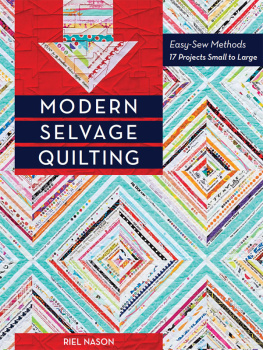
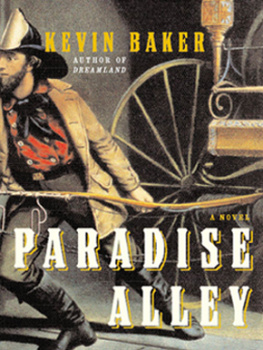
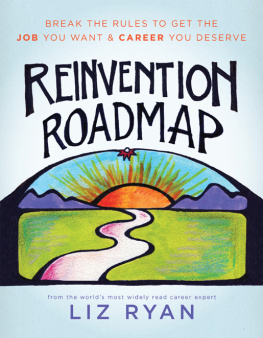
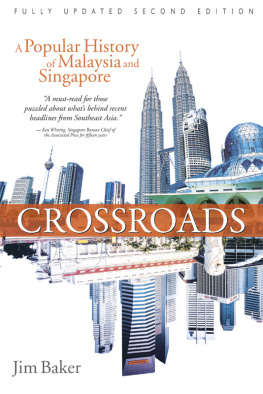

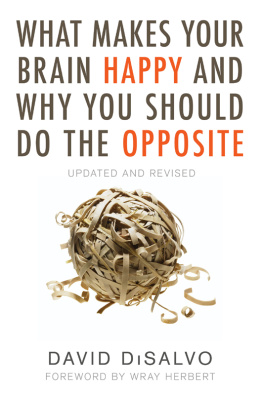
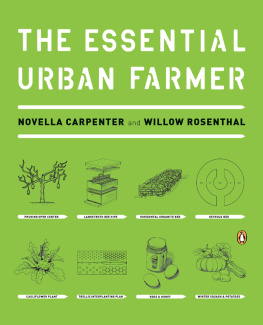

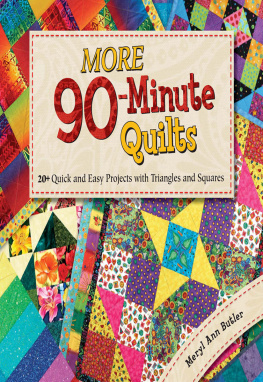
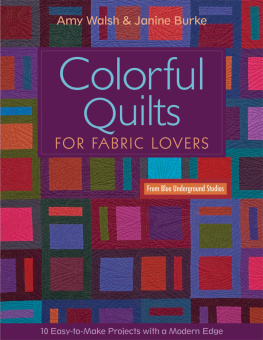


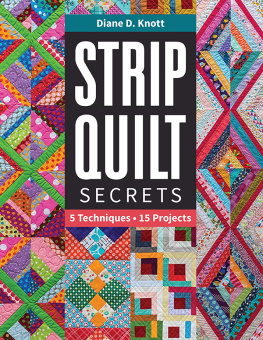
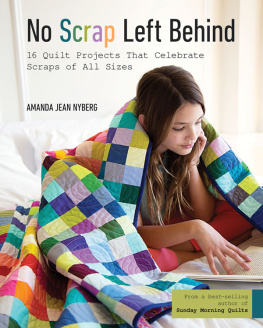
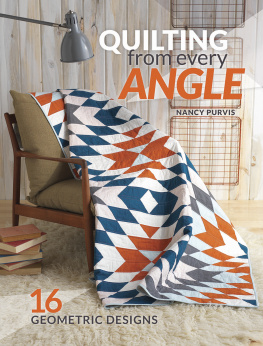
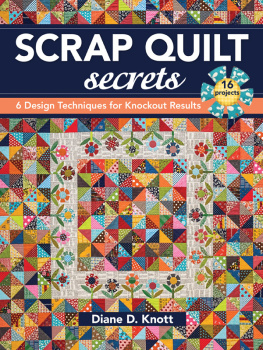


 THE BEGINNINGI have no idea who started all this. I never metin fact I dont even know the name ofthe woman who first made me think I could be a quilter.
THE BEGINNINGI have no idea who started all this. I never metin fact I dont even know the name ofthe woman who first made me think I could be a quilter.